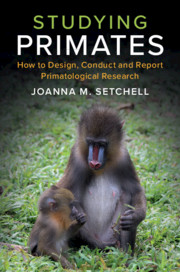Book contents
- Studying Primates
- Studying Primates
- Copyright page
- Dedication
- Contents
- Preface
- Acknowledgements
- 1 Asking Questions about Primates
- 2 Ethics in Primatology
- 3 Keeping Science Healthy: Research Integrity
- 4 Inclusive Science
- 5 Understanding Statistical Evidence
- 6 Communicating Ideas in Writing
- 7 Introduction to the Primates
- 8 Why Study Primates?
- 9 Identifying a Research Question
- 10 Finding Out What We Know
- 11 Reading Journal Articles
- 12 Formulating Hypotheses and Predictions and Designing a Study
- 13 Observing and Manipulating
- 14 Choosing Measures
- 15 Planning Data Analysis
- 16 Sampling and Statistical Power
- 17 Checking Feasibility and Finalising Your Plans
- 18 Writing a Research Proposal
- 19 Collecting Data
- 20 Conducting Fieldwork
- 21 Analysing and Interpreting Data
- 22 Writing a Scientific Report
- 23 Submitting to a Peer-Reviewed Journal
- 24 Presenting Your Work at a Conference
- 25 Conclusions
- Index
- References
24 - Presenting Your Work at a Conference
Published online by Cambridge University Press: 19 September 2019
- Studying Primates
- Studying Primates
- Copyright page
- Dedication
- Contents
- Preface
- Acknowledgements
- 1 Asking Questions about Primates
- 2 Ethics in Primatology
- 3 Keeping Science Healthy: Research Integrity
- 4 Inclusive Science
- 5 Understanding Statistical Evidence
- 6 Communicating Ideas in Writing
- 7 Introduction to the Primates
- 8 Why Study Primates?
- 9 Identifying a Research Question
- 10 Finding Out What We Know
- 11 Reading Journal Articles
- 12 Formulating Hypotheses and Predictions and Designing a Study
- 13 Observing and Manipulating
- 14 Choosing Measures
- 15 Planning Data Analysis
- 16 Sampling and Statistical Power
- 17 Checking Feasibility and Finalising Your Plans
- 18 Writing a Research Proposal
- 19 Collecting Data
- 20 Conducting Fieldwork
- 21 Analysing and Interpreting Data
- 22 Writing a Scientific Report
- 23 Submitting to a Peer-Reviewed Journal
- 24 Presenting Your Work at a Conference
- 25 Conclusions
- Index
- References
Summary
Conferences are an excellent opportunity to hear about the latest news in your field. They are also a great chance to meet like-minded people, share experiences, discuss ideas and gain inspiration. Friendships, collaborations, new research directions, invitations and job offers can all arise from conversations at conferences. Conferences range from small regional or national gatherings to huge international meetings. They may address a particular topic or may be a more general meeting of a learned society, including symposia on a variety of topics as well as society business meetings. Conferences may have only one session, with all delegates in the same room at the same time or may have multiple concurrent sessions in a conference venue where all the rooms and corridors look the same and it’s very easy to get lost. Most conferences include keynote or plenary presentations by major researchers in the field. This is a great chance to meet the people whose articles you have read and admired. In this chapter, I cover preparing and submitting an abstract, then attending a conference. Next, I provide general advice on presentations, then cover preparing and presenting oral and poster presentations. I end with conference etiquette.
- Type
- Chapter
- Information
- Studying PrimatesHow to Design, Conduct and Report Primatological Research, pp. 313 - 326Publisher: Cambridge University PressPrint publication year: 2019
References
Further Reading
24.11 Further Reading
Instructions for the conference you’re attending.
Many websites give advice on conference presentations.

